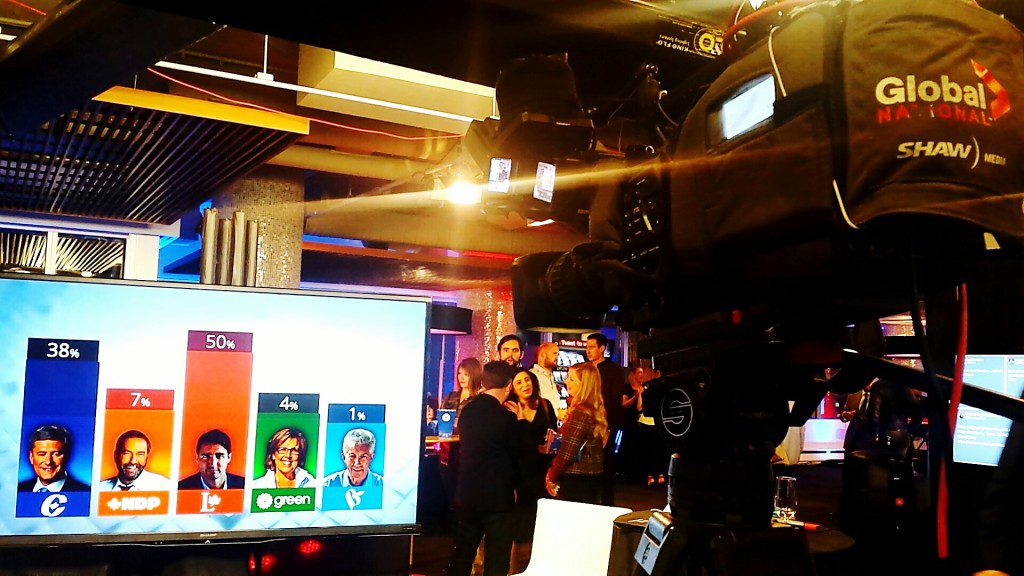On the ground floor of 121 Bloor Street East, Dawna Friesen and Tom Clark are hosting a live panel: big screens with “Decision Canada” and “Global News” behind them, three cameras in front of them. Down the hall in a back room, 20 or so analysts are calmly watching over computers as polling data and election results are updated every couple of minutes. A couple of floors up, social media — Twitter, to be exact – is having a party.
This year, Global News and Twitter Canada partnered exclusively to bring real-time, in-depth coverage of Canada’s election night for online and broadcast audiences. This partnership was unique for two reasons. First, there was an in-house team from Twitter Canada using data visualization technology to analyze live social media reactions.
This allowed on-site journalists like Global News’ Nicole Bogart to turn to the Twitter guys in the room and tell them that the hashtag #RockTheIndigenousVote was increasingly appearing on her Twitter feed because the minister of agriculture lost his seat and she needed data on it. The in-house Twitter team can then produce a cool chart for her to use in her online story.

Second, there was a Twitter-centric party, which is like every other party, except live-tweeting is encouraged.
The idea was to combine the election experience of Global News journalists with the immediacy of Twitter. Considering that over 6 million election-related Tweets were sent out over the past two-and-a-half months, it seemed reasonable to find the online conversation trends and chatter and put it into the context of the election to create what I’ve dubbed the “virtual streetcar” effect.
https://twitter.com/TwitterCanada/status/656461143351758849
News organizations are capable of doing all of this on their own, according to Steve Ladurantaye, former journalist and current head of Canadian news and government partnerships for Twitter Canada. Wanting more of the best on-screen visualizations for the widest possible audience in the face of an under-staffed and under-resourced newsroom leads to partnerships like this one.
None of this is new information. Global News was merely practicing more closely what everyone knew about the importance of social media. The average person’s reactions as well as the pundit’s and the expert’s commentary didn’t have to be sought on the streets when they could be found at the fingertips.
However, the usefulness of the inclusion of social media in election coverage remains in doubt, as will be evident by the many articles on the subject today, including this one. When Global News’ decision desk declared a Liberal majority government around 9:40 p.m., everyone at the party tweeted out their Justin Trudeau graphic and then cheered, and Bogart quickly posted how social media reacted soon after.

On one hand, the inclusion of tweets from online platforms in newspapers and broadcasts has meant that the virtual streetcar effect is working. Yet is this is at the risk of too much chatter? At one point in the night, I watched Mike Armstrong’s TweetDeck column for #elxn42 updating every second, so fast that the tweets were illegible, making it a literal “stream” of information. “It’s just noise at this point,” said Armstrong, the anchor-host of the Global News #elxn42party. Except that for the in-house Twitter guys, it was data to collect.
Election coverage is layered, nuanced and complex, but it’s also calm — or at least it seems so on the surface (unless something unpredictable happens). Social media is the opposite of that: it’s fast and it’s wild. How do you find the voice of the crowd among the millions of voices in the crowd?
Perhaps figuring that out was why Global News formed a partnership with Twitter Canada for #elxn42.
About the author
Fatima Syed is the blog editor of the spring 2016 issue of the Ryerson Review of Journalism.
